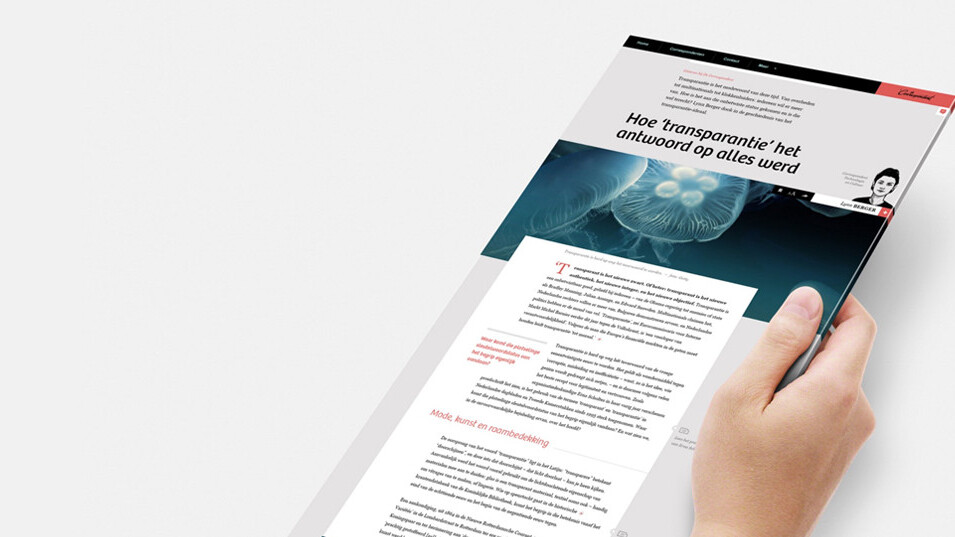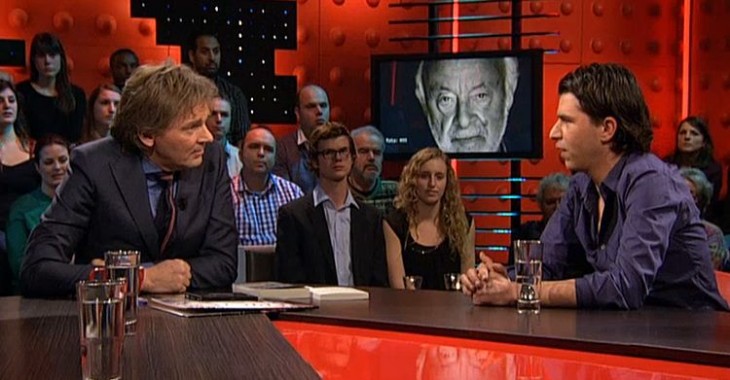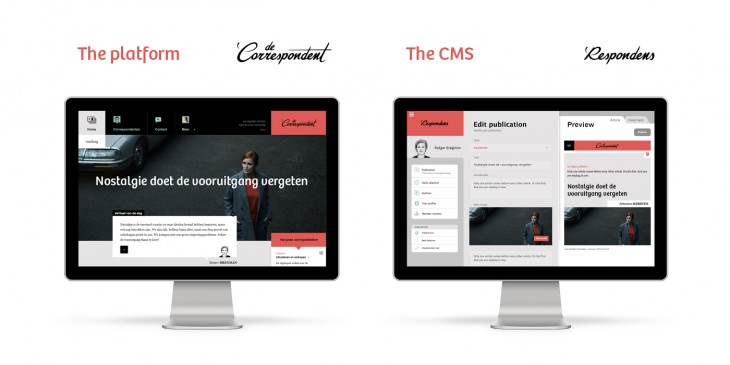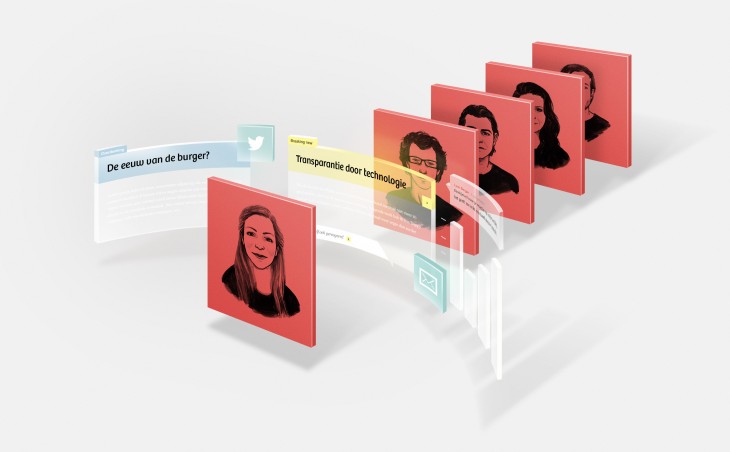
Ernst-Jan Pfauth is the former Editor in Chief of Internet at NRC Handelsblad, as well as an acclaimed technology author and columnist. He also served as The Next Web’s blog’s first blogger and Editor in Chief, back in 2008. At De Correspondent, Ernst-Jan serves as publisher, fostering the expansion of the platform. He originally published this post on on Medium.
De Correspondent is a Dutch-language, online journalism platform that offers background, analysis, investigative reporting, and the kinds of stories that tend to escape the radar of mainstream media because they do not conform to what is normally understood to be ‘news.’ We launched on September 30, after raising a total of $1.7 million with a crowdfunding campaign.
That’s it. I’m declaring De Correspondent the most interesting journalism start-up I have read about in 2013. http://t.co/LSPpQrkAem
— Jay Rosen (@jayrosen_nyu) April 8, 2013
On April 8th this year, professor Jay Rosen tweeted: “That’s it. I’m declaring De Correspondent the most interesting journalism start-up I have read about in 2013.” He had just read an article on Nieman Lab that described the world record in journalism crowd-funding we had achieved by raising $1.3 million in just the first three weeks.
When the crowd-funding campaign ended two weeks later, nearly 19,000 Dutchmen and women had invested a minimum of $80 each. From then on, we had five months to build a platform and hire an editorial staff to keep our crowdfunding promise of launching in September 2013.
Now we have a staff of seven full-time and 19 freelance writers, a website that adjusts itself to every reading device, and almost 24,000 subscribers who have a year-long subscription of $80 (€60). To put that in perspective: with the Netherlands having only 16.8 million citizens, this would be the equivalent of 450,000 subscribers for an American publication. We have a physical home in the offices of a former Shell laboratory on the shores of the river IJ, in Amsterdam.
Here’s our story.
From ‘news’ to ‘new’
In 2010, philosopher Rob Wijnberg (1982) became the editor in chief of nrc.next, the morning edition of NRC Handelsblad, the Netherlands’ premier daily national newspaper. Rob wanted to steer the newspaper away from current events, since they already get wide coverage from free and ubiquitous media outlets. Wijnberg felt that the newspaper should focus more on ‘new’ than on ‘news’ by reporting on the kinds of developments that are less spectacular than most news events, but that do have a large impact on our daily lives.
When all newspapers routinely published the yearly governmental budget memorandum on their front-pages, Rob would opt for the less covered but more influential story of refugees being traded by national governments. His superiors weren’t all happy with this atypical approach to news and asked him to leave in September 2012.
Inspired by readers of nrc.next who cancelled their subscriptions when he was fired, Rob started talking to friends and former colleagues about starting a new newspaper. In December 2012 he met up with the founders of Momkai, a creative agency with clients such as Red Bull and Nike. Lead designer Harald Dunnink helped him turn his ideas into an identity for a new online journalism publication called ‘De Correspondent’, which Momkai would build for cost price when 15,000 people invested at least €60 each during a crowd-funding campaign. I joined them as a publisher, also leaving NRC Handelsblad, where I used to be editor in chief of its website, nrc.nl.
Rob wrote a manifesto, in which he promised that ‘De Correspondent will publish fresh stories on a daily basis, but it aims to uncover, explain and highlight deep-lying structures and long-term developments that powerfully shape our world, rather than reporting on the latest hype, scare, or breaking news story.’
The kickoff on national television

On March 18th, Rob appeared on Holland’s most popular television talk show to launch the campaign. Well-known Dutch intellectuals and writers had pledged their cooperation with De Correspondent if and when the crowd-funding turned out be a success. Two of them — former leader of the Green Party Femke Halsema and documentary journalist Jelle Brandt Corstius — accompanied Rob to the television show and witnessed how, within an hour, 5,000 people invested €60 or more.
We had estimated our odds 50/50 and were stunned by the early success. Within eight days, we raised the necessary amount of money — and at the end of the crowd-funding campaign, 18,933 pioneers had invested in De Correspondent.
Building the platform and our CMS
We promised our brand new members that we would launch in September, which gave us five months to build a web app with a responsive design and hire an editorial staff. Here’s the result:
Journalists, designers and developers participated in brainstorm sessions about how De Correspondent would operate. We believe that when it comes to inventing new ways of telling stories, web-developers are as important as journalists — since they are the ones who’ve mastered the new technologies that can help us get beyond traditional publishing. Or, as Pierre Omidyar has put it recently: technologists know how to get your readers engaged and locked in into your journalism. Therefore, Momkai has joined us as a partner, so it’s ‘resting inside the news company’.
Our custom-made CMS — called Respondens — is designed to make it easy for our authors to include different media types in their articles and to set up their own corner of the site with lists of favorite books and sites, and contact information such as Pretty Good Privacy email codes. In the future, we will white-label this CMS to further finance our journalistic adventure. We might also franchise the concept in other countries.
From readers to participants
We also wanted to build a publication on which readers can contribute their expert knowledge and experience. Let’s assume that a hundred medical doctors are reading De Correspondent. Together they know much more than one medical journalist. Our site needed to be focused on enabling them to share their knowledge with our authors.
Therefore, De Correspondent aims for its authors to report on themes that transcend classic beats: themes like energy, privacy, or the economy of the future, to name a few. This reporting takes place in their own ‘gardens’ — sections of the site they can call their own, and in which they can build a relationship with readers who choose to ‘follow’ them. The main goal of this approach is to establish a lasting and meaningful relationship with our readers.
Conceived of as ‘members’ rather than ‘subscribers,’ readers are asked to contribute their expertise on specific topics. While vigilant about its editorial independence, De Correspondent believes that a unidirectional, one-to-many relationship between a news medium and its readership is wholly of the past, and that active audience involvement is crucial for maintaining a healthy, thriving platform.
When a correspondent has written a story — based on updates in his garden and the interaction with his readers — we’ll highlight this article on our general front page, so that readers who don’t follow the author will also be able to read it. This is our way of preventing a filter bubble.
Ad-free
While reading these articles, our readers won’t be distracted by advertisements, for we are an ad-free site. De Correspondent is a commercial, for-profit enterprise, but our business model focuses on selling content to readers, rather than selling readers to advertisers. Subscription fees and donations are our main source of income, and at least 95 per cent of revenues will be invested in the further development of the platform. The ultimate goal is to improve journalism, not to fill the pockets of shareholders.
Apart from promoting some of our articles in Facebook posts, we don’t advertise. We think our readers are our best ambassadors; therefore they can share as many of our articles as they want. When they share an article, a notification bar tells their friends and followers: ‘This article has been shared with you by …’, followed by the member’s name.
This strategy seems to work for now, since the ‘New visitors’ and ‘New members’ graphs show similar patterns. Moreover, we can tell that a lot of new readers sign up right after they’ve read an article. Our most popular article (203,676 unique visitors) inspired at least 147 readers to sign up right away.
In the first six weeks of our existence, almost 4,000 readers have joined us as new members. We still have a long way to go but wanted to share these first findings with you, hoping they will help you determine the strategy of your journalism endeavors.
Get the TNW newsletter
Get the most important tech news in your inbox each week.






